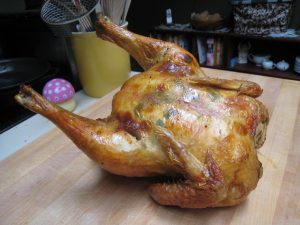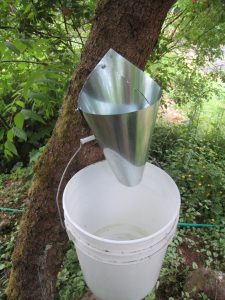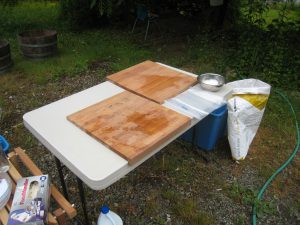The Glamourous Homesteading Life
[What follows is a relatively unfiltered description of our experiences slaughtering 14 Jumbo Cornish Cross hens that we’d raised with the intent of humanely raising and slaughtering chickens for meat. My descriptions of “the act” itself do not provide any detail beyond what is required to convey the actions we took. The accompanying images are really no more graphic than you’d see at a neighborhood butcher’s shop with a few exceptions: Americans aren’t accustomed to seeing their food with the head and feet still attached.
Consider that this is a very humane version of what occurs with the prep of the meat you eat. I encourage you to read on and contemplate the choices you make with your food.]
A dull ache in every vertebrae of my back, my calves are burning, and I can't move my neck. We're standing over the cutting board, on opposite sides of the kitchen counter pulling off crispy bits of skin, white and dark meat, and shoveling it into our mouths. Just a bit of butter, salt and pepper at 350 in the convection oven and it tastes like this? This is amazing. Ouch, my neck.

An hour before, we were in the front yard off the edge of the driveway gutting this same bird. There's no way I thought I'd bring myself to eat it today. Following the visceral, bloody, and somewhat disturbing experience, I was left with passable knowledge of chicken anatomy and a freezer full of vacuum sealed whole birds, halves, quarters, parts, and offal. Over the course of two days we slaughtered 14 Jumbo Cornish Cross chickens. Some parts of the process are pretty nasty and I was pretty sure I'd spoiled my appetite for poultry for the foreseeable future. But here I was... eating the chicken I'd just killed... and it was easily one of the tastiest things I'd eaten in a long time.
Having slaughtered a rooster, last year, we changed our approach. We learned a lot in the slaughter of Bucket. I quite simply hacked off his head with a big sharp chefs' knife coming down on a stump. The results were pretty messy, as the involuntary flapping made it tough to hang onto him. The scalding water was too hot and had actually started to cook the meat. We devised a plan, learning from experiences and a fair amount of reading. We were ready.
Slaughter day. We woke up early and started the prep. Big Rubbermaid tubs, a folding table (our kitchen from Burning Man), a large propane burner and 30 quart stock pot, ice, some really sharp knives, cutting boards, Latex gloves, 5 gallon buckets, 1 gallon Ziploc bags, and some trash bags. After working through some kinks (cone too big, angle of cutting boards wrong, broken thermometer, water too hot, water too cold, need some chairs, better knife needed for this or the other, ran out of propane on this tank, need another bucket, etc.), the next two days followed the same pattern, one or two birds at a time.

I built a small cone out of some galvanized roof flashing and a couple small bolts. The cone was affixed to the tree, with a 5-gallon bucket hanging below it. At first catching one bird at a time was easy, there were 14 of them and they were, I think I mentioned this once or twice, lazy and fat. I entered their little pasture, walked up and grabbed one. Walking back, I'd put it upside down through the cone, holding the feet, wait for the bird to calm down (the cone seemed to have this effect on them), and with the sharpest knife we own, cut through the jugular vein on the side of the neck. The blood would run down into the bucket suspended below, and half a minute later, the bird would pass out. This method is similar to the slaughter outlined in the Koran in preparation of "halal" meats.
While there is very little literature on humane slaughter of fowl, I endeavor to end the lives of any animals I kill in the most humane way possible. I've had a few muted debates with friends about the concept of "humane slaughter" and, while I agree the phrase is material enough for several comedy routines, it captures what I'm trying to do. Why raise an animal in a humane way, only to end its life in fear? Dr. Temple Grandin is an expert on humane slaughter of livestock and, while most of her work is geared toward large mammals, I found much of her writing useful. She's published some simple guidelines, many of which seem like common sense (keep herd animals together as long as possible, don't let them witness the slaughter of another, etc.), but are useful when considering what we're doing and why. The method we chose for slaughter is condoned, by her, for most animals. She's a really interesting person and I highly recommend looking her up, even if you're only marginally interested in slaughter; she's written books on autism and has a very unique first-person perspective on the topic.
After the bird fell unconscious, I'd tighten my grip on its feet. "Death throws" are involuntary muscle spasms that cause the bird to flail about (the source of the phrase "like a chicken with its head cut off") for 15-20 seconds. The cone contained the wings and held them against the body, which made this easier. The bird was dead, now.

We'd laid out our workspace in such a way as to let us progress with each of the bird through "stations," each with a separate purpose. While I have the strong urge to define the process with a flow chart, swim lane diagrams, input and output charts, and SLAs, it's pretty simple:
- Dead chicken goes into 140° Fahrenheit water and sits for 30 seconds. This loosens the feathers for plucking.
- Hot wet smelly chicken (smells like a wet feather pillow covered in chicken poop) goes into Rubbermaid tub filled with ice water. This keeps the chicken from cooking and helps to loosen the feathers. We occasionally had 3 or 4 floating around in the ice bath, gruesome looking.
- Pull a wet cold chicken out of cold water tub and starts plucking into a second Rubbermaid tub. This is much harder than it seems like it should be and my ex was much better at it than I.
- When the majority of the feathers were off, the chicken would be moved to the first of two cutting boards. Pinfeathers and as much stubble as can be pulled off is; wingtips are a particular bitch.
- On the same cutting board, I'd cut off the head (sharp knife, lots of pressure) and the feet. I got good at taking off the feet, at the knees, using a sharp knife I'd pop the tendons and separate the cartilage.
- Feet get the 'skin' and 'toenails' pulled off. The feet are a great reminder of the animals' prehistoric roots... more reptilian than bird.
- Feet go into a bag for stock.
- Bird moves to second cutting board. At this point, it looks almost like the chicken you would buy in a store.
- Gutting the bird takes a little bit of time, though I got much faster by the end of the second day. In short, I start at the top, free the "top organs" and then do the other end.
- The trachea and esophagus can be pretty easily freed from the spinal column with hands. On day one, we didn't feed the birds, and the crop was small and easily freed. The "crop" is a small sack that contains all the food the chicken has recently eaten. Think of it as a squirrel's cheek pouch, it allows the chicken to take in more than the digestive system can handle. Day two, we fed them and the crop was huge and messy. Did I mention that these chickens really ate a lot?
- I would hang the legs of the bird off the table, over a 5 gallon bucket, cut a circle (or modified square, usually) around the "vent" (aka. butt), grab around the vent and pull. Put bluntly, this is nasty. I was basically pulling the entire digestive system of a chicken out, through its butt. It smells pretty strongly. I can't describe the smell, other than to say it smells like chicken guts.
- There's a lot of cleanup on the bird that occurs at this point, too. I pack the livers, gizzards, and hearts into an "offal" bag. I hope to make some pate or a terrine; I tried each of these fried, that weekend, and couldn't stomach it. The smell was... too familiar. Discarding the rest, including lots of little bits that took time to get out (lungs, for instance).
- What's left is exactly what you'd get if you bought a whole chicken at the store. The only notable difference is that the neck has a little extra skin left on it. We either froze them like this or broke it down further to breasts, thighs, wings, etc.
Wednesday afternoon, I found myself kneeling in a 3×5 foot shed with a 1500 watt space heater between my legs, a small LED flashlight in my teeth, and my back up against a propane powered hot water heater. The majority of the words coming from my mouth were expletives. Occasionally dashing out of the shed around to the front of our house and shouting, "TURN ON THE BATHTUB!" and running back to the shed. This continued for close to two hours. When I returned to the house my knees and back hurt.
You might ordinarily assume that my behavior was a result of mental illness, some bizarre prayer ritual, or a really quirky exercise routine. In this instance, though, I was attempting to return water service to our house.
The extraordinarily low temperatures we've had over the past few days froze a few of our pipes, including those surrounding the well pump pressure switch.
The pressure switch regulates the operation of our submersible well pump, based on the pressure that's built up in two 75G tanks and the house pipes. By design, when the pressure drops below 35/40 PSI, the 'cut in' function of the switch is triggered and the pump runs until the pressure switch reaches the 'cut out' pressure (~60 PSI, in our case). It's how our "water pressure" (at the faucet) is maintained.
Early Wednesday morning, the shower died halfway through the morning routine... it just stopped. We came to the conclusion that the water mains from the pump had frozen. We relocated a small space heater from the greenhouse to the garage, aiming it at the exposed galvanized pipe, and took off for work. We returned at 4 in the afternoon (around sunset) and my adventure ensued. After presumably thawing the pipes with a space heater, we still faced no water pressure in the house. I checked the well house and discovered some very chilly pipes, including drain valve that was frozen solid. Moved the space heater, again, this time to the well house... after the drain valve had visibly thawed, I flipped an L-shaped bail to reset the pressure switch. The encouraging snap of an electric arc and the needle moved from the ambient tank pressure (30 PSI) straight up to 70 PSI, only to drop back to 30, a second later. Another attempt with similar results.
After re-reading some information I'd found a few months back and a call to my father, who lived off-grid for 12 years and just knows this stuff, I was determined to figure it out. That's where this post began... on my knees, with a small wrench, trying to adjust the 'cut in' pressure downward enough to get the pump running without hand-holding. I gave up. I spent some time with my new friend this morning, then, around noon, caved and called a service company. Late afternoon, I called to see if they were going to be able to make it. "Sure, he's in your area and should be there in a couple hours." Around 7:30, I talked to the service guy and he made it pretty clear that he wasn't going to attempt to drive out into the sticks with the roads unplowed.
Thursday, we awoke to 7 inches of snow. Determined to gain running water, again, I decided to spend some more quality time with my friend, the pressure switch. There's no way these 'snow wimp' service guys were going to drive out here. I was convinced that something had become lodged under the diaphragm/pressure plate and it just needed to be cleaned.
After all, I'm a smart guy and somewhat mechanically inclined, right? This is what I wanted, right? Yeah, we're working to become self sufficient and I just need to persevere, right?
I flipped the breaker to kill the pump circuit and made my way out to the well house. I took a picture of the switch without the cover, so I'd remember the wiring. 20 minutes later, I'd pulled the wiring off the switch, drained the last couple gallons out of the well tanks, and unscrewed the switch. I brought it inside, removed the screws from the bottom, pried the switch open, and pulled out the rubber diaphragm. No gunk. Huh... there goes that theory. I reassembled it, put it back in place, reconnected it to the house wiring, flipped the circuit back on, and went back out there.
After an hour of futzing with the two adjustment screws, I had it cycling pretty reliably. The radical change in pressure had shaken loose some rust and corrosion, but hell, it's water, right?
Punchline to the story? Sometime between the pipes freezing on Wednesday morning and this Thursday afternoon, we ran out of propane. The company that we'd contacted to refill the tank every 2 months, somehow lost our account. So, after all this hoopla, I still don't get a hot shower.
A few things I've learned from this:
- The pressure switch is a really simple and elegant electo-mechanical device.
- Having the propane hot water heater and well tanks in the same shed is a poor idea. Too little ventilation and the thermocouple on the water heater will burn out. Too much and the pipes/tank/switch will freeze in the winter.
- We really could survive here with very little from the outside (no, we're not survivalists). While it'd degrade our quality of life some, we could boil water from the creek on the wood stove.
- 3 conductor 10 gauge romex is a pain in the butt, in enclosed spaces.
- Sometimes, even paying someone to do it doesn't mean it's going to get done. Just do it yourself, city boy.
A couple helpful links:
http://pumpsandtanks.com/faq_page.htm
http://www.inspect-ny.com/water/Water_Pump_Control_Repair.htm